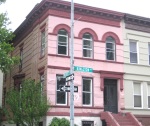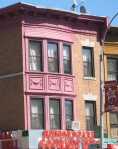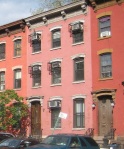Posts Tagged ‘New York City tenements’
July 3, 2014
The iconic New York City walkup comes in all colors . . . but these are the only two I’ve ever seen that show off the red, white, and blue.

This one is across the street from the Port Authority on 42nd Street. It’s the longtime home of Kaufman Army Navy Store, opened in the 1940s.
Why the American flag colors? A descendant of the store’s founder had the facade painted in 1969 as a “nod to the tradition of patriotism of military surplus stores from the 1950s,” quotes the New York Times in this story about Kaufman’s.

Not to be outdone, this tenement on Avenue B (aka, the “German Broadway”) and East Fourth Street wears its patriotic colors (plus a little gold) proudly.
Tags:42nd Street tenements, Avenue B German Broadway, Kaufman's Army Navy 42nd Street, New York City tenements, old tenements NYC, Red white and blue buildings, tenements East Village
Posted in East Village, Holiday traditions, Lower East Side, Midtown | 4 Comments »
September 20, 2012
 Used to be that ships and hurricanes were typically named after women.
Used to be that ships and hurricanes were typically named after women.
And it seems that tenement and prewar developers used the same tradition when they named New York’s residential buildings.
The surviving monikers are a glimpse into the favored female names of the era.
The Sylvia is a six-story building at 59 West 76th Street. So who was Sylvia?
No one knows for sure, but one theory is that the name comes from Shakespeare’s heroine in “Two Gentlemen of Verona.”
Anastasia Court, built in 1926, is on Fourth Avenue in Bay Ridge.

The Florence is another old-world beauty out in Bay Ridge. It’s not the only Florence in the city.
There’s a Florence walk-up tenement at 128 Second Avenue at St. Marks Place and another on Atlantic Avenue in Brooklyn.

And this Morningside Heights tenement, The Bertha, isn’t the only Bertha in Manhattan. There’s another in Harlem.

Bertha and Florence: Clearly two very popular chick names back in 1900!
Tags:Anastasia Court Bay Ridge, apartment building names, female names buildings, girls names tenements, New York City tenements, tenement names, The Bertha, The Florence, The Sylvia 76th Street
Posted in Brooklyn, East Village, Random signage, Upper West Side/Morningside Hts | 10 Comments »
December 24, 2011
The names chiseled onto city tenement building entrances are often pretty puzzling.
The typical tenement is more than 100 years old. With the original builders long-gone, who can explain where some of these names come from, and why they were chosen?

Like Novelty Court, on Driggs Avenue in Williamsburg. Actually, a little research turned up an explanation: this used to be the site of the Novelty Theater, according to Cinema Treasures, which disappeared from city directories by the 1920s.

A. Segal’s (Secal’s?) Apartments are also in Williamsburg. But who was A. Segal, and why did he put his first initial and last name on his building?

Blennerhasset sounds like Manhasset, a town in Long Island. I’ve never seen the name anywhere else but on this tenement near Columbia University.

Who was Frances, and how would she feel about the terrible shape the building named for her is in, on Lexington Avenue in East Harlem?
Tags:A. Segal's Apartments Williamsburg, Blennerhasset, East Harlem tenements, New York City tenements, New-law tenements NYC, Novelty Court, Novelty Theater Williamsburg, tenement names
Posted in Brooklyn, Cool building names, Random signage, Upper Manhattan, Upper West Side/Morningside Hts | 15 Comments »
April 12, 2011
 If you were a poor city resident in the late 19th century, you may have called an old-law tenement home.
If you were a poor city resident in the late 19th century, you may have called an old-law tenement home.
These were dumbbell-shaped buildings with four apartments to each floor, three rooms in each, one after the other.
As you can see here, your living quarters probably were probably dark and dank.
That’s because before 1901, tenements were only required to have one window per apartment or a tiny air shaft for ventilation.
The kitchen may have looked like this. It came equipped with a bathtub and stove. A spigot for water may have been in the hall.

As for toilet facilities, they were communal. You either went in the hall or in an outhouse between tenements (as seen below), or on the roof.

Tenement life improved somewhat after 1901, when new-law tenements were mandated by the city: These were required to have bathroom facilities and running water in each apartment, and a window in every room.
A major improvement, but not for the thousands of people still stuck in hot, stinky, firetrap old-law units.
[All photos courtesy of the NYPL digital collection]
Tags:dumbbell tenement, inside view of a tenement, New York City in the 19th Century, New York City tenements, new-law tenements, old-law tenements, outhouses in New York City, tenement kitchens, tenement toilets, the backyard of a tenement
Posted in Disasters and crimes, Politics | 14 Comments »
March 31, 2011
 The color pink symbolizes many things: femininity, love, youth, happiness, joy.
The color pink symbolizes many things: femininity, love, youth, happiness, joy.
 It’s about passion without aggression, and pink roses are given to convey gratitude and appreciation.
It’s about passion without aggression, and pink roses are given to convey gratitude and appreciation.
It’s an unusual color to paint a brownstone or tenement. Yet pink buildings are all over New York.
With cherry blossom season upon us and parts of the city about to be draped in fragile pink leaves for a few weeks, it’s a good time to highlight some of the pinkest houses on the streets of New York.
 Like the sweet little brownstone (top left) with the red trim on Kingston Avenue in Crown Heights.
Like the sweet little brownstone (top left) with the red trim on Kingston Avenue in Crown Heights.

Or the pink rowhouse near the Bedford Park 4 station in the Bronx (top right).
I love this pale pink tenement at left, on Grand and Orchard.
The Lower East Side can look kind of grim; it gives the neighborhood a jolt of color.
The three-story pink brownstone on the right is part of the Mott Haven Historic District in the South Bronx.
And finally, twin hot pink residences on Prince Street near West Broadway.

Tags:cherry blossoms in New York City, New York City tenements, New York street, pink brownstones, Pink houses New York City, what pink symbolizes
Posted in Bronx and City Island, Brooklyn, Lower East Side, SoHo, Urban beauty | 16 Comments »
March 8, 2010
I’ve seen New York tenement stoops flanked by carvings of lions, dragons, grotesques, even topless women.

But I haven’t seen many dogs—like this little pug (and his buddy on the left side of the stairs, not pictured), both in repose outside a tenement in the East Village.
Someone give him a new coat of paint….
Tags:carvings on tenements, dog sculptures in New York City, dogs in New York City, East Village Tenements, New York City tenements, street art in New York City, Tenements in New York
Posted in East Village, Music, art, theater | 3 Comments »
September 8, 2009
Most city tenements are marked at the top by a name, presumably of the builder, and the year the structure was completed.
But at 744 Ninth Avenue, off 50th Street, the tenement is named “9th. Ave. Flat.” It seems to be a pretty fanciful moniker for a typical red-brick tenement building; “French flats” at the time were usually higher-end apartments for middle-class New Yorkers.

Perhaps the builder had amenities inside—private baths?—that put it a notch above the usual late 19th century tenement apartment.

Also on Ninth Avenue in Hell’s Kitchen is another strangely named tenement building. I wonder what “Foresters Home” was—just a tenement put up by a man named Forester? Or maybe some kind of charity residence that housed orphans or the indigent.
Only two 8s remains from the two inscriptions announcing the date it was built: 1880.
Brownstoner’s Montrose Morris has more on the French Flats building boom.
Tags:9th Ave Flats, Forresters Home, French Flats, French Flats in New York City, Hell's Kitchen tenements, New York City tenements
Posted in Cool building names, Hell's Kitchen, Random signage | 4 Comments »
November 14, 2008
Some of the faces carved into city buildings are beautiful and peaceful. Others, like these, seem pained and distressed. What’s the story behind their expressions and why they’re paired up? If only we knew.
In the West Village, this man and woman are locked in a gloomy stare:

Troubled spirits East of Union Square:

On the facade of the Camelot, a tenement in the South Bronx, these two have never actually seen each other:

Tags:bas relief, gargoyles, New York City tenements, sculptures on buildings
Posted in Bronx and City Island, Cool building names, Music, art, theater, Union Square, West Village | 5 Comments »



























